
 |
Tea Clipper |
 |
| from TeaAntiques.com | ||
| Edition Thirty One |
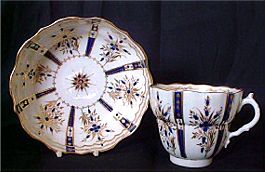
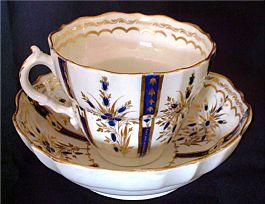 This
must be one of the most exquisite Caughley cups and saucers that I have ever offered
for sale. This magnificent cup and saucer is of a large size, like a breakfast
cup and saucer, and most beautifully shaped and decorated. The cup and saucer
are both clearly marked with the Caughley under glaze 'Salopian' mark of an
underglaze 'S'. This stunning cup and saucer was made at the Caughley factory in
Shropshire c1785.
This
must be one of the most exquisite Caughley cups and saucers that I have ever offered
for sale. This magnificent cup and saucer is of a large size, like a breakfast
cup and saucer, and most beautifully shaped and decorated. The cup and saucer
are both clearly marked with the Caughley under glaze 'Salopian' mark of an
underglaze 'S'. This stunning cup and saucer was made at the Caughley factory in
Shropshire c1785.
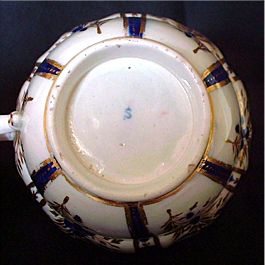 The
cup has a rare pan shaped bowl, which has a scalloped rim and stands on a raised
circular foot. There is a very elegant and finely moulded handle to the cup,
which has a raised thumb piece on its top edge.
The
cup has a rare pan shaped bowl, which has a scalloped rim and stands on a raised
circular foot. There is a very elegant and finely moulded handle to the cup,
which has a raised thumb piece on its top edge.
A truly magnificent, very rare and decorative Caughley cup and saucer, c1785. A cup and saucer for the connoisseur of Caughley or English porcelain of the eighteenth century.
More details of this item and other tea related antiques can be found by visiting my web site at www.TeaAntiques.com.
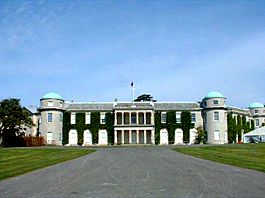 The
ancestral home to
the Dukes of Richmond, Goodwood House proudly sits at the foot of the South Downs. This magnificent house is unusual in appearance with its three angular
wings that extend from an earlier house, which is now set rather
awkwardly behind and forming part of the left wing of the present house. Built of local flint, it has four round towers, two at the end
of the extreme wings and two flanking the central block.
The
ancestral home to
the Dukes of Richmond, Goodwood House proudly sits at the foot of the South Downs. This magnificent house is unusual in appearance with its three angular
wings that extend from an earlier house, which is now set rather
awkwardly behind and forming part of the left wing of the present house. Built of local flint, it has four round towers, two at the end
of the extreme wings and two flanking the central block.
The Richmond family stems from Charles Lennox, an illegitimate son of King Charles II, who became the fist Duke of Richmond. He was born in 1672, the son of the King and Louise de Keroualle, Duchess of Portsmouth. The first Duke married Anne, the daughter of Lord Brudenell and grand daughter of the Earl of Cardigan in 1692. He bought the house at Goodwood in 1697, it was then little more than a rather small hunting lodge. It was here that the very first fox hunts took place in England and was a popular hunting location, visited by another son of King Charles II, the Fist Duke of Monmouth.
The first Duke of Richmond had a son, also called Charles who was born at Goodwood in 1694. After his father's death in 1723, he became the second Duke of Richmond. He was married in unusual circumstances! He married Sarah, daughter of the Earl of Cadogan in payment of a gambling dept owed to the Earl! The marriage took place at The Hague. Straight after the wedding, the second Duke left his wife behind and went off on the Grand Tour of Europe with his tutor, lasting three years. Upon his return to England, rather than to see his wife, he went straight out to the theatre! At the theatre, he observed a beautiful lady in the audience. Enquiring as to whom this beautiful lady was, he was informed that it was 'the reigning toast of the town, Lady March' - his wife! From then on, he and his wife Sarah lived a devoted life together for 28 years and had twelve children.
The second Duke of Richmond was an avid collector and one of his collections was to keep many wild animals and birds, including a lion, ostriches, eagles, bears and a tiger. He created a menagerie for the animals behind the house in 1725. He was extremely proud of his collection and when his lioness died he had her buried in the grounds and on her grave he had a life sized stone lion placed. This stone lion remains on this site today.
When the second Duke died in 1750, he was succeeded by his son Charles, who became the third Duke of Richmond. It is the third Duke who created much of what is to be seen at Goodwood today. With close links to the crown, he held the 'Sceptre with the dove' at the coronation of King George III. One of the important positions that he held for one year in 1765 was as Ambassador Extraordinary to the court of Louis XV at Versailles, France. It was during this year in France and close to Louis XV, that the third Duke bought some magnificent French furniture and porcelain for his home at Goodwood. With King Louis XV owning the porcelain manufactory of Sèvres, he was obviously encouraged to buy much Sèvres porcelain-which he certainly did.
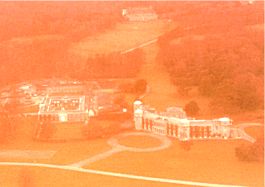 Goodwood
House underwent improvements under the third Duke. These improvements by designs
of Sir William Chambers, included changes to the original hunting lodge in the
1760's and a grand stable block in the 1750's. Later, in the eighteenth century,
he also added the three grand wings with the four towers to a design for an
'octagon' shaped house, by James Wyatt. The plan to build the octagon was never
completed, so remains with only three sides of the octagon complete. This aerial
view shows these three wings of the octagon. I apologise for the quality of this
picture, it was taken a few years ago when I held my Private Pilots' Licence and used to fly regularly from
nearby Goodwood airfield.
Goodwood
House underwent improvements under the third Duke. These improvements by designs
of Sir William Chambers, included changes to the original hunting lodge in the
1760's and a grand stable block in the 1750's. Later, in the eighteenth century,
he also added the three grand wings with the four towers to a design for an
'octagon' shaped house, by James Wyatt. The plan to build the octagon was never
completed, so remains with only three sides of the octagon complete. This aerial
view shows these three wings of the octagon. I apologise for the quality of this
picture, it was taken a few years ago when I held my Private Pilots' Licence and used to fly regularly from
nearby Goodwood airfield.
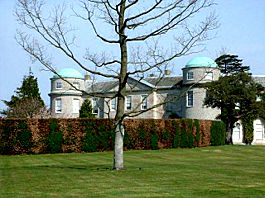 One of the three wings with
towers was in fact created from the original Chambers additions and had two
towers put on it at either end. This Chambers wing is to the left of
the house front and has a pedimented central section.
One of the three wings with
towers was in fact created from the original Chambers additions and had two
towers put on it at either end. This Chambers wing is to the left of
the house front and has a pedimented central section.
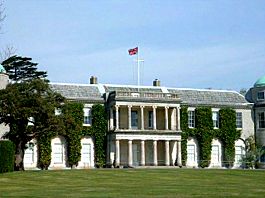 Visitors
to the house enter through the main entrance within the double height, columned
portico. This entrance leads straight into the Main Entrance Hall. This hall
forms the centre of the Wyatt house. There is a colonnade of pink Guernsey
granite columns toward the back of the hall, which rather reflect the stone
columns in the portico outside. Egyptian pink granite is used in the pediment of
the fire places which are supported by green Egyptian marble columns. The
Egyptian theme is continued in the awe inspiring Egyptian dining room to the
left of the Main Entrance Hall.
Visitors
to the house enter through the main entrance within the double height, columned
portico. This entrance leads straight into the Main Entrance Hall. This hall
forms the centre of the Wyatt house. There is a colonnade of pink Guernsey
granite columns toward the back of the hall, which rather reflect the stone
columns in the portico outside. Egyptian pink granite is used in the pediment of
the fire places which are supported by green Egyptian marble columns. The
Egyptian theme is continued in the awe inspiring Egyptian dining room to the
left of the Main Entrance Hall.
Stepping into the dining room, you could almost be instantly transported into an ancient Egyptian temple! This room, like many of the state rooms has in the last few years, been totally renovated by the current Duke of Richmond. Until recently, this dining room had been decorated as a classical Georgian style dining room, but during some building work, parts of the original Egyptian decoration came to light, including doors with Egyptian motifs and Egyptian style finger plates etc. Now the dining room walls are covered in orange marbled scagliola, topped with an Egyptian style cornice. The door frames are not rectangular, but are angled in towards the top, like the Pylon entrance to an Egyptian temple. Each door way is surmounted by a gold winged sun disc. A beautiful white marble fireplace has been recreated and has bronze Egyptian god motifs applied. The effect of the decoration in this room is so unusual to see in a stately home in England. I was informed by my guide, that the original Egyptian decoration in this room had been changed following a remark made by King Edward VII when dining in the room in the early 1900's, that 'he did not like it'. So, it was totally changed after that remark into a classical Georgian style.
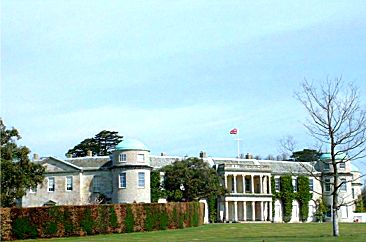 Furniture in the dining room include a very large rectangular mahogany dining
table, surrounded by a large set of Regency dining chairs. The rectangular wooden
backs of each chair has a cast bronze metal crocodiles fixed on them. These crocodiles had been
removed many years ago, being rather uncomfortable to the back when sitting on
the chairs, they were re-discovered packed away in the house attic. Up until then, only
one carver chair had the crocodile still in place, the rest believed lost. These crocodiles
now returned, complete the
Egyptian theme nicely.
Furniture in the dining room include a very large rectangular mahogany dining
table, surrounded by a large set of Regency dining chairs. The rectangular wooden
backs of each chair has a cast bronze metal crocodiles fixed on them. These crocodiles had been
removed many years ago, being rather uncomfortable to the back when sitting on
the chairs, they were re-discovered packed away in the house attic. Up until then, only
one carver chair had the crocodile still in place, the rest believed lost. These crocodiles
now returned, complete the
Egyptian theme nicely.
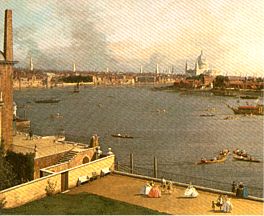 Walking back into the Main Hall, the visitor then has to go outside from a
door at the back of the hall, to walk round
into what was the original early hunting lodge. Inside this part of the house
there is the Long Hall, this was formed by Chambers changes to the lodge. In this
hall there are two stunning large Canaletto paintings showing views of London,
these were commissioned by the Duke of Richmond. One
of these paintings is of the view from the window of the Duke of Richmond London
home, 'Richmond House' (the house is no longer there). This house stood on the bank of the Thames at Whitehall. This painting,
very detailed shows the area of Whitehall and what remained at this period of
the early palace of Whitehall. The second painting (a copy I located on the
sleeve of a CD of Handles Water Music by Innovative Music Productions Ltd. -
PCD826), shows again a view from
Richmond house, this time towards the river Thames. The detail in this painting
include the churches of Sir Christopher Wren, St Paul's cathedral on the sky
line and also the
Duke of Richmond himself and his family walking along the bank of the river.
Walking back into the Main Hall, the visitor then has to go outside from a
door at the back of the hall, to walk round
into what was the original early hunting lodge. Inside this part of the house
there is the Long Hall, this was formed by Chambers changes to the lodge. In this
hall there are two stunning large Canaletto paintings showing views of London,
these were commissioned by the Duke of Richmond. One
of these paintings is of the view from the window of the Duke of Richmond London
home, 'Richmond House' (the house is no longer there). This house stood on the bank of the Thames at Whitehall. This painting,
very detailed shows the area of Whitehall and what remained at this period of
the early palace of Whitehall. The second painting (a copy I located on the
sleeve of a CD of Handles Water Music by Innovative Music Productions Ltd. -
PCD826), shows again a view from
Richmond house, this time towards the river Thames. The detail in this painting
include the churches of Sir Christopher Wren, St Paul's cathedral on the sky
line and also the
Duke of Richmond himself and his family walking along the bank of the river.
Leading from the Long Hall is the most beautiful Tapestry Drawing Room. This really delightful room was redesigned by Wyatt to accommodate a very fine set of four French Gobelin tapestries, purchased by the third Duke of Richmond when he was Ambassador in France. These tapestries are known as the 'Marly tapestries' as 30 had been ordered and the King of France, Louis XV, used 12 to decorate his chateau at Marly. These stunning tapestries are in remarkable condition and the colours are extremely vivid. They depict the story of Don Quixote and are the work of Michael Audran and Pierre Francois Cozette. There is also, a magnificent suite of floral silk covered gilt framed French Louis XV furniture. Our present Queen Elizabeth II, has held several Privy Council meetings in this room when she stayed at the house for the famous Goodwood horse racing.
Returning across the open court yard to the main part of the house, there are some very gracious state rooms to be seen. The Yellow Drawing Room, like the dining room has recently been completely redecorated, the walls hung round with bright yellow stripped silk, as near in colour and design as the original hangings. Like the Tapestry Drawing room, this room is filled with some extremely high quality gilt French furniture. The room contains many contemporary portraits of the family, including some by Sir Joshua Reynolds. A portrait of the third Duke of Richmond are among the paintings in this room.
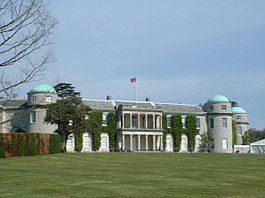 In one of
the round towers at the end of the Yellow Drawing Room is a small circular room, known
as the Card Room, so called because Edward VII, a visitor to the house would play at
cards in this room. However, this room is an exciting one for me as the curved walls
are lined with integral glass fronted display cabinets, in which are some of the finest
Sèvres
porcelain that I have seen. There is a comprehensive tea service with a
bright pea green ground, exquisite gilding and painted in white panels with detailed
realistic natural birds. It is a truly stunning set. Interestingly, the
illustration for the birds on this French porcelain was in fact copied from an English book on birds,
which has many delightfully coloured plates of birds. The painters at the Sèvres factory used
this book to create their painting on the pieces of porcelain. I was
particularly fascinated to see that one of the pictures of a bird painted on one
of the pieces of Sèvres had the ancient English monument of 'Stone Henge'
painted behind a bird, this was copied straight from one of the
illustration in the book. A copy of the book plate, hangs framed on the wall
so that a comparison can be made. For the tea antique lover, there are some
extremely fine tea items in this set, including some glorious little teapots.
In one of
the round towers at the end of the Yellow Drawing Room is a small circular room, known
as the Card Room, so called because Edward VII, a visitor to the house would play at
cards in this room. However, this room is an exciting one for me as the curved walls
are lined with integral glass fronted display cabinets, in which are some of the finest
Sèvres
porcelain that I have seen. There is a comprehensive tea service with a
bright pea green ground, exquisite gilding and painted in white panels with detailed
realistic natural birds. It is a truly stunning set. Interestingly, the
illustration for the birds on this French porcelain was in fact copied from an English book on birds,
which has many delightfully coloured plates of birds. The painters at the Sèvres factory used
this book to create their painting on the pieces of porcelain. I was
particularly fascinated to see that one of the pictures of a bird painted on one
of the pieces of Sèvres had the ancient English monument of 'Stone Henge'
painted behind a bird, this was copied straight from one of the
illustration in the book. A copy of the book plate, hangs framed on the wall
so that a comparison can be made. For the tea antique lover, there are some
extremely fine tea items in this set, including some glorious little teapots.
Also, within the cabinets of the Card room is a charming little enamelled snuff box, given to the second Duke of Richmond by Henry Fox, who had secretly married the Duke's eldest daughter, Caroline, against the Duke's will. After this marriage Caroline and Henry Fox were banished from visiting the Duke's house for many years, until later a visit took place and Henry Fox presented this box to the second Duke of Richmond. This snuff box contained a portrait of Caroline on the inside of the lid, it was given as a gesture of peace and good will between them.
From the Yellow Drawing Room, the visitor is led through to the Ballroom. A grand and very impressive room, hung with many Royal portraits and ancestors of the Richmond family. It is hard to believe that during the war in 1939-45, this house was used as a hospital for injured soldiers and this ballroom used as one of the wards! Now it is returned to its former glory and magnificent it looks too.
I can certainly recommend a visit to Goodwood House, especially for those who appreciate the very best in French Sèvres porcelain, French furniture and Gobelin tapestries. I hope that you manage to visit and enjoy Goodwood house as much as I did.
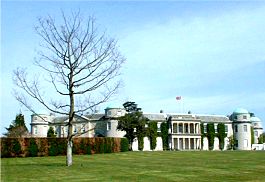 Goodwood House
Goodwood House
Goodwood
Chichester
PO18 0PX
Tel: 01243 755000
Fax: 01243 755005
Website: www.goodwood.co.uk
Click here for
Local Map
Map courtesy of www.streetmap.co.uk
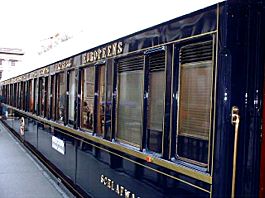
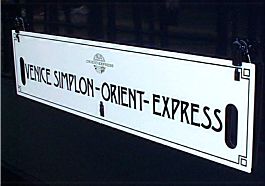 The
'Orient Express', a name that conjures up a grand style and relaxed way of travelling
of
days gone by. However, the Orient Express is alive and running popular tours
across major cities in Europe, as well as journeys in South east Asia, Australia
and Peru.
The
'Orient Express', a name that conjures up a grand style and relaxed way of travelling
of
days gone by. However, the Orient Express is alive and running popular tours
across major cities in Europe, as well as journeys in South east Asia, Australia
and Peru.
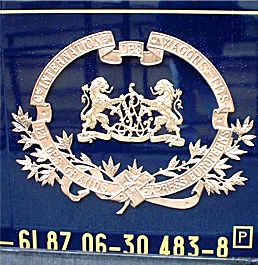
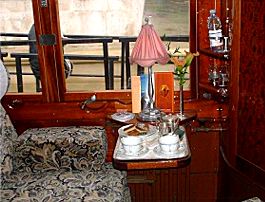 The
image and affluent style of the Orient Express has not changed, it provides
first class travel on trains that are clean and gleaming both inside and out.
Here on board, the way in which afternoon tea is served remains a very elegant tradition.
The
image and affluent style of the Orient Express has not changed, it provides
first class travel on trains that are clean and gleaming both inside and out.
Here on board, the way in which afternoon tea is served remains a very elegant tradition.
I have been fortunate to travel on the English Orient Express a few times, which runs various tourist trips to parts of the British Isles. These pictures were taken during a luncheon excursion through the garden of England, a train journey though the country side of South East England.
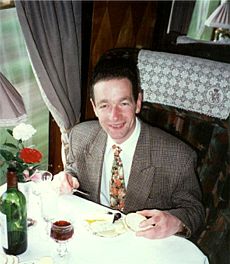 The Orient Express first ran in 1883 and has since maintained its gracious
and elegant way in which to travel. The British Pullman conducted the
British part of the journey towards Europe, taking passengers from London to the
Folkestone port on the South Coast from where passengers embarked the ferry
to France. From France they embarked the European Orient Express to take them on
in full and gracious glory, to destinations such as Paris and Venice.
The Orient Express first ran in 1883 and has since maintained its gracious
and elegant way in which to travel. The British Pullman conducted the
British part of the journey towards Europe, taking passengers from London to the
Folkestone port on the South Coast from where passengers embarked the ferry
to France. From France they embarked the European Orient Express to take them on
in full and gracious glory, to destinations such as Paris and Venice.
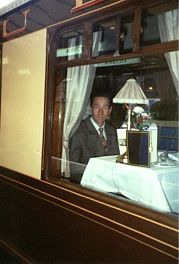
 The
British Pullman train carriages are restored from the original 1920's and 30's
stock and are
beautiful painted in brown and cream livery, with gleaming brass fixtures and
fittings. The inside of each carriage is beautifully decorated with wood panelled walls,
embellished with unique and different marquetry pictured panels. Attention to
detail is meticulous in both the service and the surroundings. The seating is
extremely comfortable, having wide moveable arm chairs. The menu and food on offer is
equivalent to the menus of top class hotels, the only difference being that you
can sit, relax and enjoy it whist passing through delightful rolling countryside.
The
British Pullman train carriages are restored from the original 1920's and 30's
stock and are
beautiful painted in brown and cream livery, with gleaming brass fixtures and
fittings. The inside of each carriage is beautifully decorated with wood panelled walls,
embellished with unique and different marquetry pictured panels. Attention to
detail is meticulous in both the service and the surroundings. The seating is
extremely comfortable, having wide moveable arm chairs. The menu and food on offer is
equivalent to the menus of top class hotels, the only difference being that you
can sit, relax and enjoy it whist passing through delightful rolling countryside.
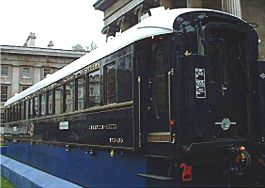
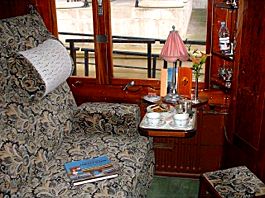 Although
I have not had the good fortune to do the journey between London and Venice, I
did visit one of the carriages from the European Orient Express that had been on display
at the British Museum, London, during part of 2002. I could see here at
first hand the elegance afforded the passengers on this journey. There are
luxuriously fitted compartments. Passengers have their own personal steward to
attend their needs and to make sure their journey is a comfortable one. I was
pleased to see that the tradition of serving afternoon tea to passengers in
their compartments is continued today. In one of the carriages compartments
there was set a tea tray, upon which sat a silver teapot, milk jug, sugar bowl
together with 'Orient Express' porcelain cups and saucer. A fine selection of
afternoon cakes and biscuits are provided with the tea. What a perfect way in
which to take afternoon tea. If only such service was available on our modern
trains around Britain!
Although
I have not had the good fortune to do the journey between London and Venice, I
did visit one of the carriages from the European Orient Express that had been on display
at the British Museum, London, during part of 2002. I could see here at
first hand the elegance afforded the passengers on this journey. There are
luxuriously fitted compartments. Passengers have their own personal steward to
attend their needs and to make sure their journey is a comfortable one. I was
pleased to see that the tradition of serving afternoon tea to passengers in
their compartments is continued today. In one of the carriages compartments
there was set a tea tray, upon which sat a silver teapot, milk jug, sugar bowl
together with 'Orient Express' porcelain cups and saucer. A fine selection of
afternoon cakes and biscuits are provided with the tea. What a perfect way in
which to take afternoon tea. If only such service was available on our modern
trains around Britain!
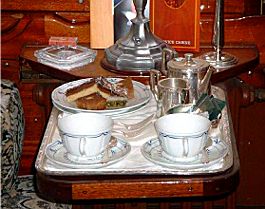
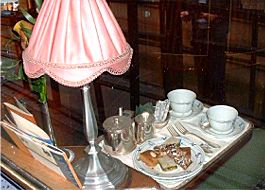
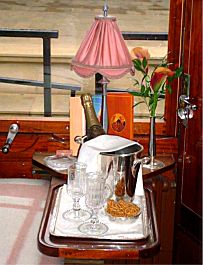 As well
as tea, passengers can enjoy drinks in their compartments, pre-dinner cocktails
in the Bar Car and dinner in one of the Dining Cars.
As well
as tea, passengers can enjoy drinks in their compartments, pre-dinner cocktails
in the Bar Car and dinner in one of the Dining Cars.
It is wonderful to know that the tradition of fine afternoon tea remains safe and sound on the Orient Express.
For more information, visit their web site: www.orient-express.com
Venice-Simplon-Orient Express Ltd.
Sea Containers House, 20, Upper Ground.
London
SE1 9PF
Tel: 020-7805 5060
Fax: 020-7805 5908
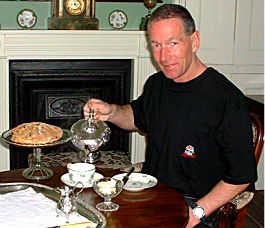
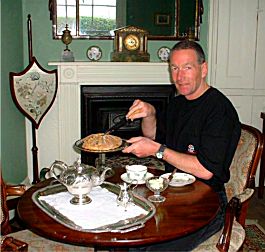 I recently received a recipe from a great American friend
of mine, Rebecca Hare (of Hares Ltd), who as a fellow dealer, is a
great enthusiast of quality antiques and also of good food. She kindly sent me a
recipe that appears to be a cross between a Irish soda bread and a fruit scone
together with some extra tasty ingredients that produce a fine afternoon
alternative to English scones, cream and jam. Rebecca, recommended that this
‘Irish Bread’, as she called it, should be eaten warm and spread with lashings
of good butter! I could not resist the challenge of having a go at producing one
and trying with my afternoon tea. The results was very delicious, producing a
light textured scone (or bread), sweet to the taste but with an unusual zing of
Orange and the crunchiness of caraway seeds.
I recently received a recipe from a great American friend
of mine, Rebecca Hare (of Hares Ltd), who as a fellow dealer, is a
great enthusiast of quality antiques and also of good food. She kindly sent me a
recipe that appears to be a cross between a Irish soda bread and a fruit scone
together with some extra tasty ingredients that produce a fine afternoon
alternative to English scones, cream and jam. Rebecca, recommended that this
‘Irish Bread’, as she called it, should be eaten warm and spread with lashings
of good butter! I could not resist the challenge of having a go at producing one
and trying with my afternoon tea. The results was very delicious, producing a
light textured scone (or bread), sweet to the taste but with an unusual zing of
Orange and the crunchiness of caraway seeds.
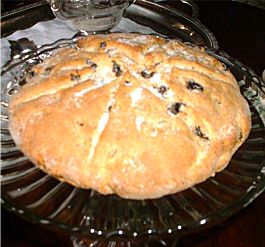
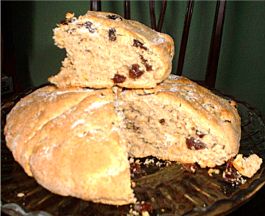 With Rebecca’s kind permission, I would like to share this
tea time treat with you. I hope that you have good results in making it and are
able to sit down with a good pot of tea and enjoy a slice or two, spread with
the all essential butter. I found that a tea like ‘Lady Grey’ or ‘Empress of
India’ were a wonderful match to the fruity bread.
With Rebecca’s kind permission, I would like to share this
tea time treat with you. I hope that you have good results in making it and are
able to sit down with a good pot of tea and enjoy a slice or two, spread with
the all essential butter. I found that a tea like ‘Lady Grey’ or ‘Empress of
India’ were a wonderful match to the fruity bread.
Sieve the flour into a bowl together with the baking powder then add the salt and sugar and mix together. Rub in the butter until the ingredients resemble very fine bread crumbs. Mix in the raisins, caraway seeds and grated orange rind, then add the milk in stages to produce a firm dough. Knead the dough a little to form a smooth ball. Roll out to a 9” diameter on a metal baking sheet and using a knife score the surface into about six equal portions. Pop into a pre-heated oven for about 25-30 minutes or until cooked and nicely browned.
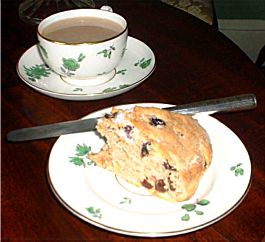
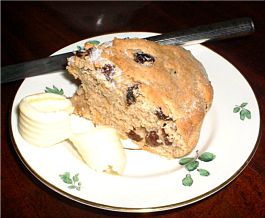 Remove from the oven when cooked and cool slightly on a
wire tray for short while before serving whilst still quite warm. Split the
slices and serve spread thickly with butter, sit back and enjoy the experience!
Remove from the oven when cooked and cool slightly on a
wire tray for short while before serving whilst still quite warm. Split the
slices and serve spread thickly with butter, sit back and enjoy the experience!
Thank you Rebecca for the recipe (and thanks also to my customer Karen, for the NBC Tee Shirt!)
To review past newsletters, just follow this link:
Past newsletters.
To subscribe to this free newsletter -
Click here